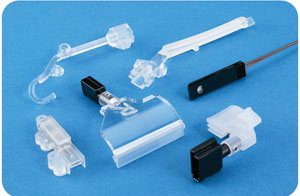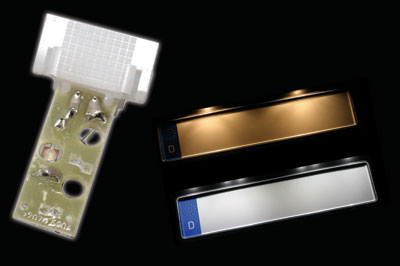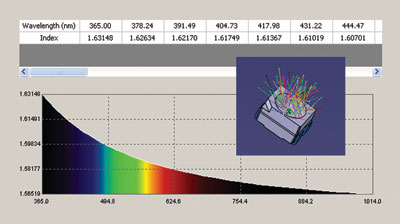If you are lucky enough to own or test drive a luxury car in Europe today, you may notice what is "comfort lighting" in the car. More than just interior lighting, it also includes the use of mood settings in different interior spaces to control the color and brightness of the “personal spaceâ€, such as the driver's foot space or the backlight of the console. Comfortable lighting can be done very beautifully and provide a soothing space for the passengers inside. This can be a supplement to conventional interior lighting or a complete replacement for "undercarriage" lighting.
This article refers to the address: http://
LEDs for illuminating indications are used in large numbers in today's automotive lighting applications. They can be integrated near the door handle, used for keyhole illumination, or a turn flash on the mirror, as well as pedal lighting and cup holder illumination. The shape of the illuminating indicator can be very simple (direct light transmission), but it can also be done very complicated, as shown in Figure 1, to meet the needs of precise lighting.

Figure 1 LEDs and lighting indications in automotive lighting

You may be wondering how the light appears to be bent at 90° or 180° and still have enough light output to perfectly illuminate the area of ​​the door handle with precise brightness and coverage. This possibility is almost limitless, and it is only limited by the design ideas, styles and functional concepts of the interior lighting designer.
Recent market research indicates that in Europe, Asia and the United States, almost all car manufacturers plan to use some kind of non-traditional lighting or indicating system in their new cars, depending on the configuration of the luxury features. However, these lighting systems have very strict design considerations, including light pipe tightness, wavelength quality and consistency, and test testing.
Light pipe tightness One of the main design considerations of these systems is the degree of tightness of the light within the light pipe, which should limit the loss of light when the light source illuminates the target. Once the light is emitted from the light pipe, it should only be illuminated within the target range and not outside the target range.
Two of these design requirements can control how light exits the light pipe by properly processing the inner surface of the light pipe and by constructing the scattering shape and calibration surface of the appropriate light exit point. Since the light-emitting surface of an LED is only a small fraction of a standard incandescent lamp, any loss of light can be a cut-off point from "successful design" to "unstable prototype."
As shown in Figure 2, light can be emitted from a surface mount LED device mounted on a small PCB board using a current limiting resistor and a reverse polarity protection diode. Light is directed onto a simple or well-designed light pipe, which is an extremely simple way to bind light. A more common method is to use a suitable "lens" or light-emitting face, and the mounting method is often carried in the interior of the car into the opening of the door panel, the center console or the dashboard.

Figure 2 The internal structure of the lighting system and the license plate illumination with the outer casing removed
Suitable internal surface treatments and modern mold techniques make it possible for light to be efficiently absorbed by the light pipe, to limit losses and to internally reflect light to a certain distance and to form a specific light indicating shape. In the past, some comfortable lighting designs that should be illuminated directly with incandescent lamps were not considered from a decorative point of view, so they were not used in actual products. In other words, LEDs and their light pipes have lower dimensions, heat dissipation, current requirements, overall weight and cost compared to similar incandescent lamps.
Comfort lighting systems are designed to illuminate certain objects or concentrate light into a certain area, so they can create special effects, from displaying the manufacturer's brand logo on the roof to lighting a larger shaded area. Simulated light curtain effect.
Figure 2 depicts an example of two license plate lighting. One example describes two independent, non-guided light sources that do not fully illuminate the license plate, but leave dark areas; the other describes a light curtain made with a light pipe that illuminates the license plate more evenly. A light curtain can be used to achieve better illumination, while only a very low current and very thin wires are needed to carry these currents, and more consistency in color and illumination is achieved, and bulbs are not needed.
Another aspect of wavelength quality and design consistency that differs from traditional incandescent lighting is that the concept of all comfort lighting has been proven before they are prototyped using spectral analysis and illumination simulation software. As shown in Figure 3, all LEDs, regardless of their declared output color, include a very broad spectral component in the visible spectrum. In European car design, software is used to develop various levels of comfort lighting, which can use text and graphics to show what color is actually emitted.

Figure 3 Simulation software for displaying the exact spectrum of the LED and the direction of the light radiation
Designers should be aware that car manufacturers want every car produced to have a good color consistency, so they must also maintain consistency between lighting components. Automotive manufacturers need LEDs with specific wavelengths or "colors" to keep the LEDs used in their branded car comfort lighting systems consistent. At the same time, the automakers must maintain the consistency of their automotive products many years later.
The color of the LED illumination depends on the material properties in the diode semiconductor junction. In order to emit light of a particular color, these materials must be doped with arsenic, gallium and other mixtures.
Leading suppliers' LEDs are divided into different grades or groups, containing colors that are more or less consistent in color batches. When the grouping in the level is increased, it is possible to ensure that there are more LEDs of similar colors. Designers should have a clear understanding of the supplier's color grading scheme to meet their own LED color tolerances and specifications. When the car manufacturer specifies wavelength or color standards for the LEDs used, the color of the interior lighting will be the same in each car, just as the car's exterior paint color remains the same.
Reliability and testing Imagine the harsh environment faced by LEDs inside the car, which can be heated to over 200oF, or as low as the coldest outside the car. Moreover, the LEDs themselves are very susceptible to damage due to vibration, shock, or moisture, as are their PCBs, connectors, and light pipes, as well as various other causes of driving that can cause malfunctions.
One design consideration is that if the manufacturing process is not followed during the manufacturing process, the light guide may be broken, discolored, and dark. Light guides made of inexpensive materials start to turn yellow if exposed to high temperatures for a long period of time. Therefore, high-quality heat-resistant materials are a major consideration in the optical and physical reliability of light guides. High-grade polycarbonate is ideal for these applications. With modern, ultra-high pressure injection molding technology, polycarbonate light pipes will provide superior light transmission properties over other materials for a long time.
Designers should consider that in the aftermarket of the car, it is possible to apply a reverse polarity voltage to the comfort lighting system due to carelessness. Fortunately, the wires are connected using a connector with a keyway, and if repairs are required, use the original recommendations. However, if these connectors are replaced incorrectly and a reverse voltage is applied, it is possible to burn out the comfort lighting system components. To protect the LED, a reverse polarity protection diode and current limiting resistor should always be used. It is very common to cancel these devices in order to reduce costs (only $0.005), which is actually a wrong economic account.
Proper design, manufacture and installation of a comfortable lighting system is a science in itself. For LEDs and illuminated indicators to achieve a comfortable lighting system, a creative design, real model testing and complete system testing are just as important as other systems in the car.
Small Crystal Chandeliers,Chandelier,Pendant Light,Ceiling Light
Crystal Chandeliers, Ceiling Lights Co., Ltd. , http://www.nbchandeliers.com
